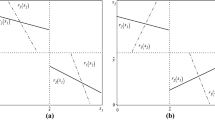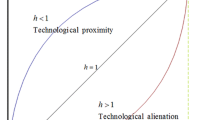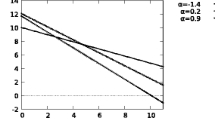Abstract
In a two-stage Cournot oligopoly where a subset of firms first make a choice between two alternative production technologies independently and then all firms compete in quantity, the effect of information spillovers is analyzed when the outcome of R&D is uncertain. It is shown that the range of parameter values that support heterogeneous firms in equilibrium will diminish as information spillovers become larger. Particularly, when the spillover effect is so strong that the investment by one firm is beneficial to its R&D active rivals, all active firms will choose the same technology. A similar result can be derived from a socially desirable point of view except that the cut-off magnitude of spillovers is different. By introducing a positive success probability to characterize the uncertainty of the R&D outcome, it is found that when information spillovers are not too small, there will be underinvestment in equilibrium relative to the social optimum.


Similar content being viewed by others
Notes
Following Jensen (1992) and Elberfeld and Nti (2004), this paper concentrates on the case where an investing firm can revert to the old technology by only losing the fixed cost of adoption if its post-innovation marginal cost is greater than the initial value, which implies that \(\Delta \) can be viewed as non-negative. Hence, it is reasonable to refer to \(\Delta \) as the cost reduction.
The support of the density function of \(\Delta \) must be restricted within the interval \(0\le \Delta <c/{[1+\beta (n-k-1)]}\), which implies that the new technology should not be too efficient, for otherwise investing firms will have zero or even negative post-innovation costs.
We greatly appreciate one reviewer for providing some valuable hints in this part.
References
De Bondt R, Veugelers R (1991) Strategic investment with spillovers. Eur J Polit Econ 7(3):345–366
d’Aspremont C, Jacquemin A (1988) Cooperative and noncooperative R &D in duopoly with spillovers. Am Econ Rev 78(5):1133–1137
Elberfeld W (2003) A note on technology choice, firm heterogeneity and welfare. Int J Ind Organ 21(4):593–605
Elberfeld W, Nti KO (2004) Oligopolistic competition and new technology adoption under uncertainty. J Econ 82(2):105–121
Hauenschild N (2003) On the role of input and output spillovers when R &D projects are risky. Int J Ind Organ 21(8):1065–1089
Hinloopen H, Vandekerckhove J (2009) Dynamic efficiency of Cournot and Bertrand competition: input versus output spillovers. J Econ 98(2):119–136
Hinloopen H (2000) More on subsidizing cooperative and noncooperative R &D in duopoly with spillovers. J Econ 72(3):295–308
Hoppe HC (2000) Second-mover advantages in the strategic adoption of new technology under uncertainty. Int J Ind Organ 18(2):315–338
Jensen R (1992) Innovation adoption and welfare under uncertainty. J Ind Econ 40(2):173–180
Katz M (1986) An analysis of cooperative research and development. Rand J Econ 17(4):527–543
Mills DE, Smith W (1996) It pays to be different: endogenous heterogeneity of firms in an oligopoly. Int J Ind Organ 14(3):317–329
Qiu LD (1997) On the dynamic efficiency of Bertrand and Cournot equilibria. J Econ Theory 75(1):213–229
Tirole J (1988) The theory of industrial organization. The MIT Press, Cambridge
Zhao J (2001) A characterization for the negative welfare effects of cost reduction in Cournot oligopoly. Int J Ind Organ 19(3–4):455–469
Zhang Y, Mei S, Zhong W (2013) Should R &D risk always be preferable? Oper Res Lett 41(2):147–149
Acknowledgments
We wish to thank two anonymous referees for constructive comments that helped to improve the presentation of this manuscript. The National Pillar Program of China (No. 2012BAH29F01), and Graduate Student Research and Innovation Program of Jiangsu Province (No. CXZZ_0187) are gratefully acknowledged.
Author information
Authors and Affiliations
Corresponding author
Appendices
Appendix A: The proof of Proposition 1
(1) Consider \(\beta <{\hat{\beta }}\), which implies that \(H(m)\) is strictly decreasing with respect to \(m\). Hence, the equilibrium number of investing firms if exists, is unique. By virtue of the assumption (1), some simple derivations can yield \(f_{n-k}>0\). Thus, we have
It only suffices to show part (ii), since part (i) and part (iii) are obvious. For later convenience, define \(g(x)\) as the largest integer equal or smaller than \(x\). In the case of \(f_{n-k} <f\le f_1 \), i.e. \(H(n-k)<0\le H(1),{\tilde{m}}\in [1,n-k)\) is the unique solution of \(H(m)=0\). It follows immediately from the monotonicity property of \(H\) that \(H( {g({\tilde{m}})+1})<0=H({\tilde{m}})\le H({g({\tilde{m}})})\), which means that \(g({\tilde{m}})\) is the equilibrium number of investing firms.
(2) Noting that \(f_1=\cdots =f_{n-k} >0\) when \(\beta ={\hat{\beta }}\), one can easily finish this proof.
(3) Consider \(\beta >{\hat{\beta }}\), which implies that \(H(m)\) is strictly increasing with respect to \(m\). Accordingly, there is no number of investing firms which satisfies the equilibrium condition \(H({\hat{m}}+1)<0\le H({\hat{m}})\). That is, \({\hat{m}}\) can only take either \(0\) or \(n-k\). Besides, it is obvious that
If \(f\le f_1 \), i.e. \(H(1)\ge 0\), it follows from the monotonicity property of \(H\) that \(H(n-k)>H(n-k-1)>\cdots >H(2)>H(1)\ge 0\). As a result, \({\hat{m}}=n-k\) is the unique equilibrium number of investing firms. Likewise, it can be concluded that \({\hat{m}}=0\) is the unique equilibrium number of investing firms if \(f>f_{n-k}\). Finally, in the case of \(f_1 <f\le f_{n-k} \), i.e. \(H(1)<0\le H(n-k)\), by virtue of the definition, both \(0\) and \(n-k\) can constitute Nash equilibria.
Appendix B: The proof of Proposition 2
(1) Consider \(\beta <{\hat{\beta }}^*\), which implies that \(G(m)\) is strictly decreasing with respect to \(m\). By the definition of \({\hat{m}}^*,{\hat{m}}^*=0\) is the socially optimal size of innovating firms if and only if \(G(1)<0;{\hat{m}}^*\in \{1,\ldots ,n-k-1\}\) is the socially optimal size of innovating firms if and only if \(G({\hat{m}}^*+1)<0\le G({\hat{m}}^*)\); and \({\hat{m}}^*=n-k\) is the socially optimal size of innovating firms if and only if \(G(n-k)\ge 0\). By virtue of the assumption (1), straightforward derivations can lead to \(f_{n-k}^*>0\). Thus, one can see that
Since claim (i) and claim (iii) are immediate, it only needs to validate (ii). In the case of \(f_{n-k}^*<f\le f_1^*\), i.e. \(G(n-k)<0\le G(1),{\tilde{m}}^*\in [1,n-k)\) is the unique solution of \(G(m)=0\). Given that \(G(m)\) is strictly decreasing with respect to \(m\), we have \(G({g({\tilde{m}}^*)+1})<0=G({\tilde{m}}^*)\le G( {g({\tilde{m}}^*)})\), which means that \(g({\tilde{m}}^*)\) is the socially optimal size of innovating firms.
(2) Consider \(\beta \ge {\hat{\beta }}^*\), which implies \(G(m)\) is weakly increasing with respect to \(m\). Since \(\phi (\beta )>0\), it is clear that \(f^*>0\). It can be concluded that \({\hat{m}}^*\) can only take \(0\) or \(n-k\). Otherwise, \(r\in \{1,\ldots ,n-k-1\}\) is the socially optimal size of innovating firms. Then \(G(r)\ge 0>G(r+1)\), which is in contradiction to the monotonicity of \(G\). Noting that
one can easily finish the proof.
Appendix C: Some lemmas
In this part, some necessary preliminaries are provided in order to prove Proposition 3 and Proposition 4. Lemma 1 (Lemma 2) is a direct applications of Proposition 1 (Proposition 2) in the simple stochastic version. It should be noted that the results are presented in a more explicit way.
Lemma 1
Let
-
(1)
If \(\beta <1/2\),
$$\begin{aligned} {\hat{m}}= {\left\{ \begin{array}{ll} n, &{} \mathrm{{if}}\ f\le f_n\\ j,&{}\mathrm{{if}}\ f_{j+1} <f\le f_j,\,j\in \{1,\ldots ,n-1\}\\ 0,&{}\mathrm{{if}}\ f>f_1 \end{array}\right. }. \end{aligned}$$ -
(2)
If \(\beta \ge 1/2\),
$$\begin{aligned} {\hat{m}}= {\left\{ \begin{array}{ll} n,&{}\mathrm{{if}}\ f\le f_{n}\\ 0,&{}\mathrm{{if}}\ f>f_{n} \end{array}\right. }. \end{aligned}$$
Lemma 2
Let \(\phi (\beta )=2n+3-2(5+3n)\beta -(n^2-2n-7)\beta ^2\).
-
(1)
If \(\beta <{\hat{\beta }}^*\),
$$\begin{aligned} {\hat{m}}^*={\left\{ \begin{array}{ll} n, &{} \mathrm{{if}}\ f\le f_n^*\\ j, &{} \mathrm{{if}}\ f_{j+1}^*<f\le f_j^*,\,j\in \{1,\ldots ,n-1\}\\ 0, &{} \mathrm{{if}}\ f>f_{1}^*\end{array}\right. }, \end{aligned}$$where \(f_i^*\!=\!\frac{\theta \Delta }{2(n+1)^2}\big \{ 2(n+2)[1\!+\!(n-1)\beta ](a-c)\!+\![2(n+1)^2(1\!-\!\beta )^2 -(2i-1) \phi (\beta )]\Delta \big \}\).
-
(2)
If \(\beta \ge {\hat{\beta }}^*\),
$$\begin{aligned} {\hat{m}}^*= {\left\{ \begin{array}{ll} 0, &{} \mathrm{{if}}\ f>f^*\\ n, &{} \mathrm{{if}}\ f\le f^*\end{array}\right. }, \end{aligned}$$where
$$\begin{aligned} f^*=\theta \Delta \left\{ {(1-\beta )^2\Delta +\frac{2(n+2)[1+(n-1)\beta ](a-c)-n\phi (\beta )\Delta }{2(n+1)^2}} \right\} . \end{aligned}$$
Lemma 3
Consider \(\beta <{\hat{\beta }}^*\).
-
(1)
If \(\delta _1 (\beta )>0\) and \(\delta _i (\beta )\ge 0\) for all \(i\in \{2,\ldots ,n\}\), then \({\hat{m}}\ge {\hat{m}}^*\). Furthermore, when \(f_1^*<f\le f_1,{\hat{m}}>{\hat{m}}^*\).
-
(2)
If \(\delta _1 (\beta )<0\) and \(\delta _i (\beta )\le 0\) for all \(i\in \{2,\ldots ,n\}\), then \({\hat{m}}\le {\hat{m}}^*\). Furthermore, when \(f_1 <f\le f_1^*,{\hat{m}}<{\hat{m}}^*\).
-
(3)
If there exists \(r\in \{1,\ldots ,n-1\}\) such that
$$\begin{aligned} \delta _1 (\beta )<\cdots <\delta _r (\beta )\le 0<\delta _{r+1} (\beta )<\cdots <\delta _n (\beta ), \end{aligned}$$then \({\hat{m}}\ge {\hat{m}}^*\) when \(f\le f_r \), and \({\hat{m}}\le {\hat{m}}^*\) when \(f>f_r \). Furthermore, there always exist two ranges of \(f\) to respectively support \({\hat{m}}>{\hat{m}}^*\) and \({\hat{m}}<{\hat{m}}^*\).
Proof
We only prove part (1) and part (3), since part (2) can be obtained following the same line as the proof of part (1). It follows from Lemma 1 that
Likewise,
-
(1)
Noting
$$\begin{aligned} 0<f_n^*<f_{n-1}^*<\cdots <f_1^*<f_1, \end{aligned}$$we can complete the proof by considering the following several cases.
-
(1a)
If \(0\le f\le f_n^*\), noting that \(f_n^*\le f_n \), we have \({\hat{m}}={\hat{m}}^*=n\).
-
(1b)
If \(f_{j+1}^*<f\le f_j^*\), where \(j\in \{1,\ldots ,n-1\}\), it is clear that \({\hat{m}}^*=j\). Given that \(f\le f_j^*\le f_j,{\hat{m}}\ge j\) according to (4).
-
(1c)
If \(f_1^*<f\le f_1 \), by means of Lemma 2 and (4), we can easily obtain that \({\hat{m}}^*=0\) and \({\hat{m}}\ge 1\).
-
(1d)
If \(f>f_1 \), it is evident that \({\hat{m}}={\hat{m}}^*=0\).
-
(3)
Since
$$\begin{aligned} f_n^*<f_{n-1}^*<\cdots <f_{r+2}^*<f_{r+1}^*<f_{r+1} <f_r <f_{r-1} <\cdots <f_1 <f_1^*, \end{aligned}$$by virtue of Lemmas 1, 2, (4) and (5), we can finish this proof by Table 1, where \(j\in \{r+1,\ldots ,n-1\}\) and \(t\in \{1,\ldots ,r-1\}\).
Appendix D: The proof of Proposition 3
Setting \(n=2\), we have \({\hat{\beta }}^*=\frac{11-6\sqrt{2}}{7}\approx 0.359\) and
It follows from our basic assumption that
which means that \({\bar{\beta }}<{\hat{\beta }}^*\).
-
(1)
If \(\beta <{\bar{\beta }},\delta _1 (\beta )<0<\delta _2 (\beta )\). By virtue of Lemma 3(3), this result is clear.
-
(2)
Noticing \({\bar{\beta }}<{\hat{\beta }}^*<1/2\), this proof can be done by considering three cases.
-
(2a)
If \(\bar{\beta }\le \beta <{\hat{\beta }}^*\), \(\delta _1 (\beta )<0\) and \(\delta _2 (\beta )\le 0\). This result is obvious following Lemma 3 (1).
-
(2b)
If \({\hat{\beta }}^*\le \beta <1/2\), noting \(\phi (\beta )\le 0\) and
$$\begin{aligned} f^*-f_1 =\frac{\theta \Delta \left\{ {6\beta (a-c)+[(1-2\beta )(5-4\beta )-\phi (\beta )]\Delta } \right\} }{9}, \end{aligned}$$we can obtain that \(f^*>f_1 >f_2 \). By virtue of Lemma 1 and Lemma 2, one can easily derive Table 2, which implies our result.
-
(2c)
If \(\beta \ge 1/2,f^*>f_2 \) since
$$\begin{aligned} f^*-f_2 =\frac{\theta \Delta \left\{ {6\beta (a-c)+[5\beta ^2+2(1-\beta )]\Delta } \right\} }{9}>0. \end{aligned}$$The result follows immediately from Table 3.
Appendix E: The proof of Proposition 4
Obviously, for any \(i\in \{1,\ldots ,n-1\}\),
It is easy to see that
Besides, since
we have \(d({\hat{\beta }}^*)=d({\hat{\beta }}^*)-\phi ({\hat{\beta }}^*)=-2(1-2{\hat{\beta }}^*)[{\hat{\beta }}^*+(1-{\hat{\beta }}^*)n]<0\). Noting that \(d(\beta )\) is strictly decreasing, there exists a unique solution for \(d(\beta )\) with respect to \(\beta \in ( {\frac{n-2}{(n-1)(n+4)},{\hat{\beta }}^*})\), denoted by \(\beta ^d\). Hence, if \(\beta <\beta ^d,d(\beta )>0\), which results in
Noting that \(\frac{n-2}{(n-1)(n+4)}<\beta ^d<{\hat{\beta }}^*<\frac{1}{2}\) and \(d(\beta ^d)=0\), it is not difficult to verify that
Consequently, \(\beta ^d>{\underline{\beta }}\) and \(\beta ^d>{\bar{\beta }}\). Since \({\underline{\beta }}<\beta ^d\), it follows directly from (6) that \(\delta _n ({\underline{\beta }})>\delta _1 ({\underline{\beta }})\!=\!0\), leading to the fact that \({\underline{\beta }}<\bar{\beta }\). In sum,
-
(1)
If \(\beta <{\underline{\beta }},\delta _1 (\beta )>0\). Since \({\underline{\beta }}<\beta ^d\), it follows from (6) that
$$\begin{aligned} 0<\delta _1 (\beta )<\delta _2 (\beta )<\ldots <\delta _{n-1} (\beta )<\delta _n (\beta ). \end{aligned}$$By virtue of Lemma 3(1), we have \({\hat{m}}\ge {\hat{m}}^*\).
-
(2)
If \({\underline{\beta }}\le \beta <{\bar{\beta }},\delta _n (\beta )>0\) and \(\delta _1 (\beta )\le 0\). Hence, there exists \(r\in \{1,\ldots ,n-1\}\) such that
$$\begin{aligned} \delta _1 (\beta )<\cdots <\delta _r (\beta )\le 0<\delta _{r+1} (\beta )<\ldots <\delta _n (\beta ). \end{aligned}$$The proof can be completed by Lemma 3(3).
-
(3)
We can finish this proof by the following three cases.
-
(3a)
If \({\bar{\beta }}\le \beta <{\hat{\beta }}^*, \delta _1 (\beta )<0\) and \(\delta _n (\beta )\le 0\), which implies that \(\delta _i (\beta )<0\) for all \(i\in \{2,\ldots ,n-1\}\). By virtue of Lemma 3(2), we have \({\hat{m}}\le {\hat{m}}^*\).
-
(3b)
Consider \({\hat{\beta }}^*\le \beta <1/2\). One can easily obtain that the sigh of \(f^*-f_1 \) is determined by
$$\begin{aligned} 2[(n-1)(n+4)\beta -(n-2)](a-c)+[2(1-2\beta )(2n-2n\beta +1)-n\phi (\beta )]\Delta . \end{aligned}$$Given \(\beta \ge {\hat{\beta }}^*>\frac{n-2}{(n-1)(n+4)}\), the coefficient of \(a-c\) is positive. Since \(\phi (\beta )\le 0\) and \(\beta <1 / 2\), the coefficient of \(\Delta \) is also positive. Consequently, \(f^*>f_1 \). In sum,
$$\begin{aligned} f_n <f_{n-1} <\cdots <f_2 <f_1 <f^*. \end{aligned}$$By virtue of Lemmas 1 and 2, Table 4 is evident, which yields our result.
-
(3c)
Consider \(\beta \ge 1/2\). Some simple calculations give
$$\begin{aligned} \frac{2(n+1)^2(f^*-f_n )}{\theta \Delta }=2[(n-1)(n+4)\beta -(n-2)](a-c)+\psi (\beta )\Delta , \end{aligned}$$where
$$\begin{aligned} \psi (\beta )=(n^3+6n^2-15n+8)\beta ^2-2(3n^2-7n+4)\beta +2n^2-3n+2. \end{aligned}$$Since
$$\begin{aligned} \left\{ \begin{array}{l} {{\psi }^{\prime }(\beta )=2(n^3+6n^2-15n+8)\beta -2(3n^2-7n+4)}\\ {{\psi }^{\prime \prime }(\beta )=2(n^3+6n^2-15n+8)>0} \end{array}\right. , \end{aligned}$$\({\psi }^{\prime }(\beta )\ge {\psi }^{\prime }(1 / 2)=n(n^2-1)>0,\) which implies \(\psi (\beta )\ge \psi (1 / 2)={n(n+1)^2} / 4>0\). Obviously, the coefficient of \(a-c\) is positive. Marshaling these facts lead to \(f^*>f_n \). The result can be thus indicated by Table 5.
Rights and permissions
About this article
Cite this article
Zhang, Y., Mei, S. & Zhong, W. New technology adoption in a Cournot oligopoly with spillovers. J Econ 112, 115–136 (2014). https://doi.org/10.1007/s00712-013-0353-5
Received:
Accepted:
Published:
Issue Date:
DOI: https://doi.org/10.1007/s00712-013-0353-5




